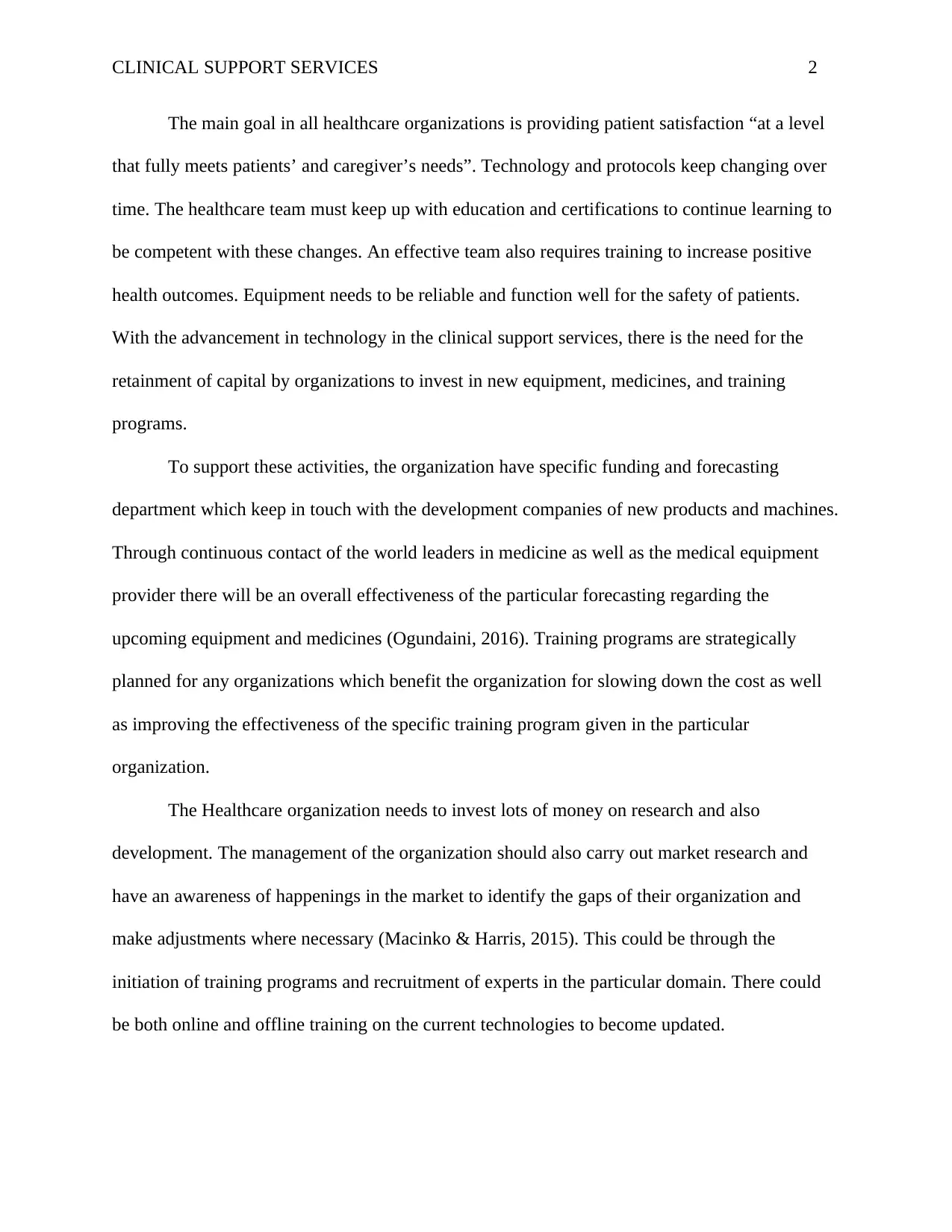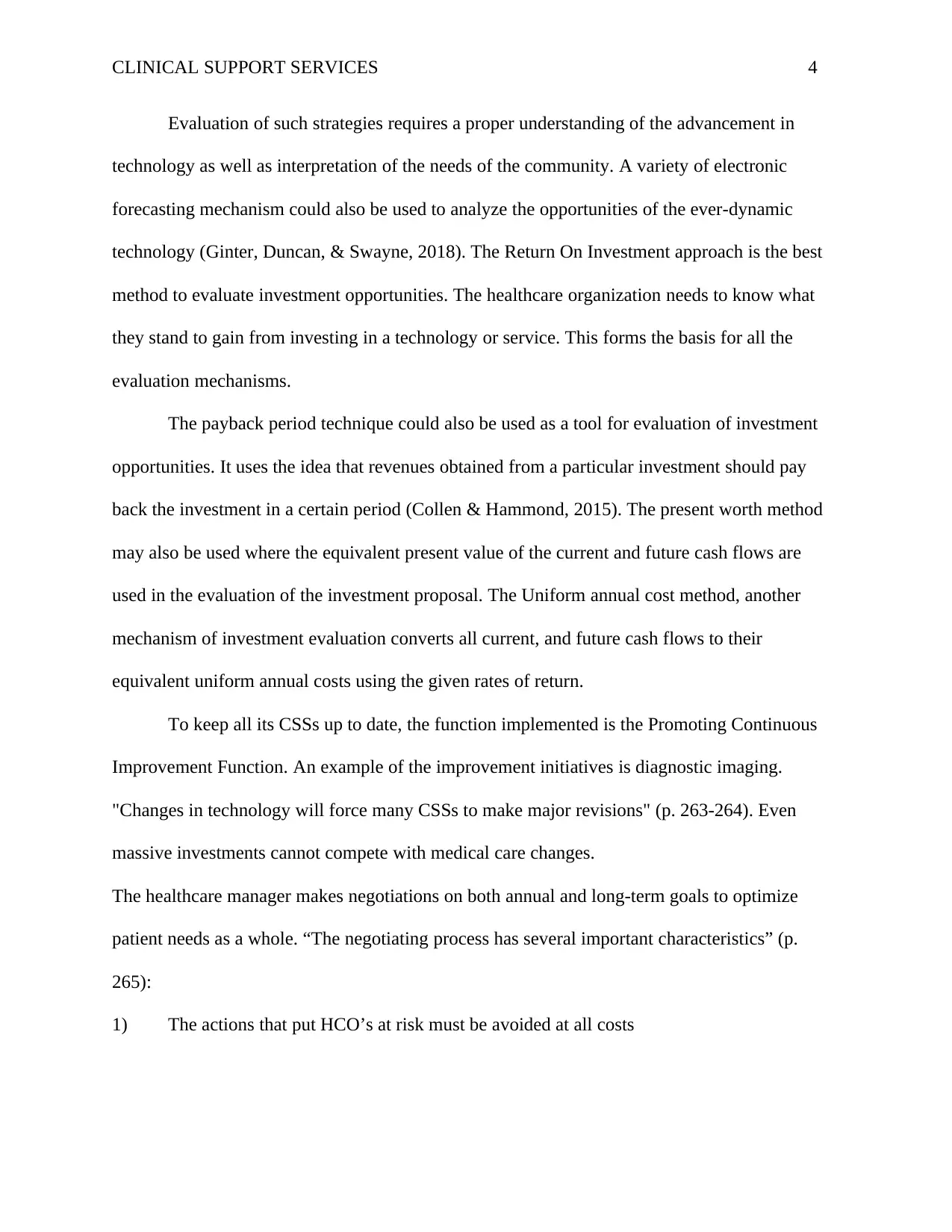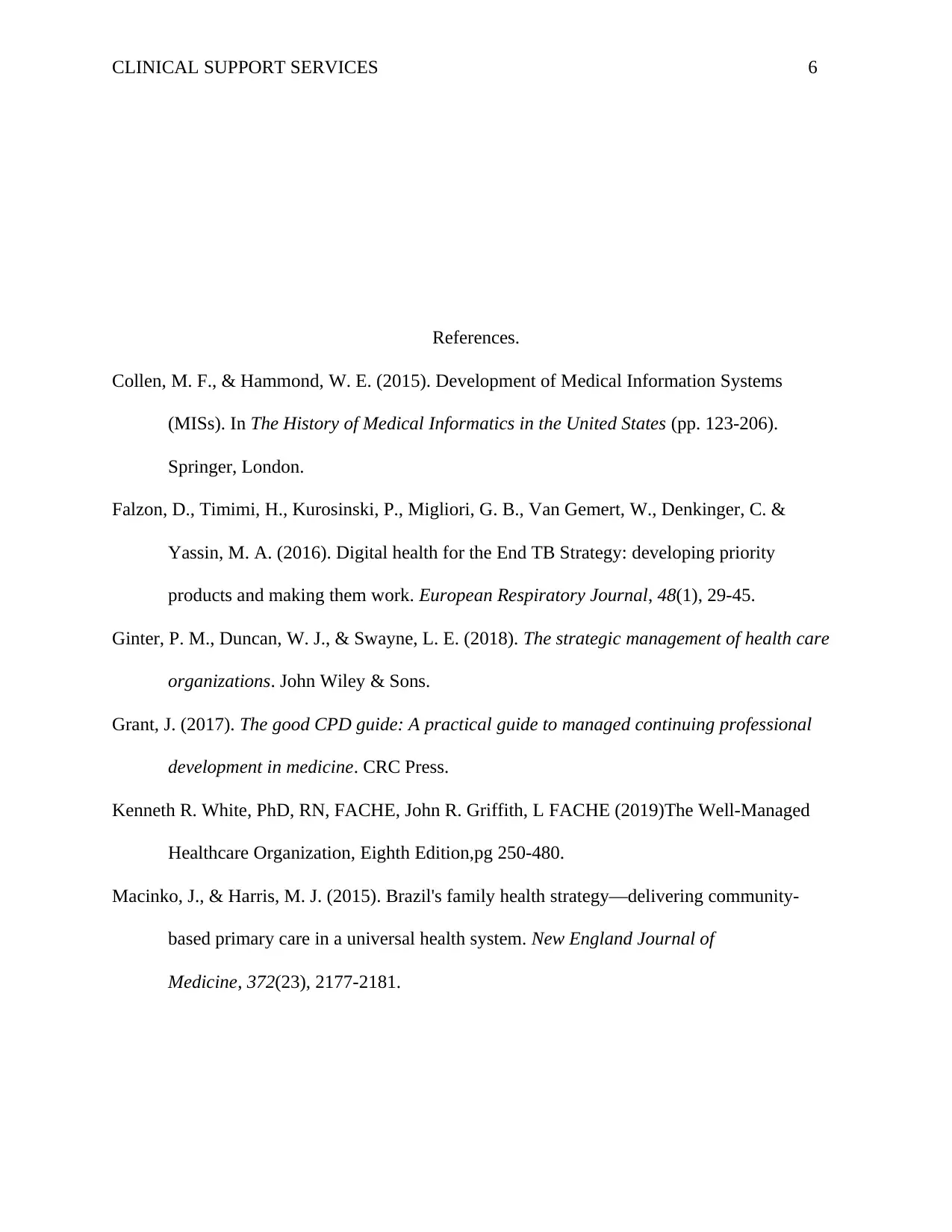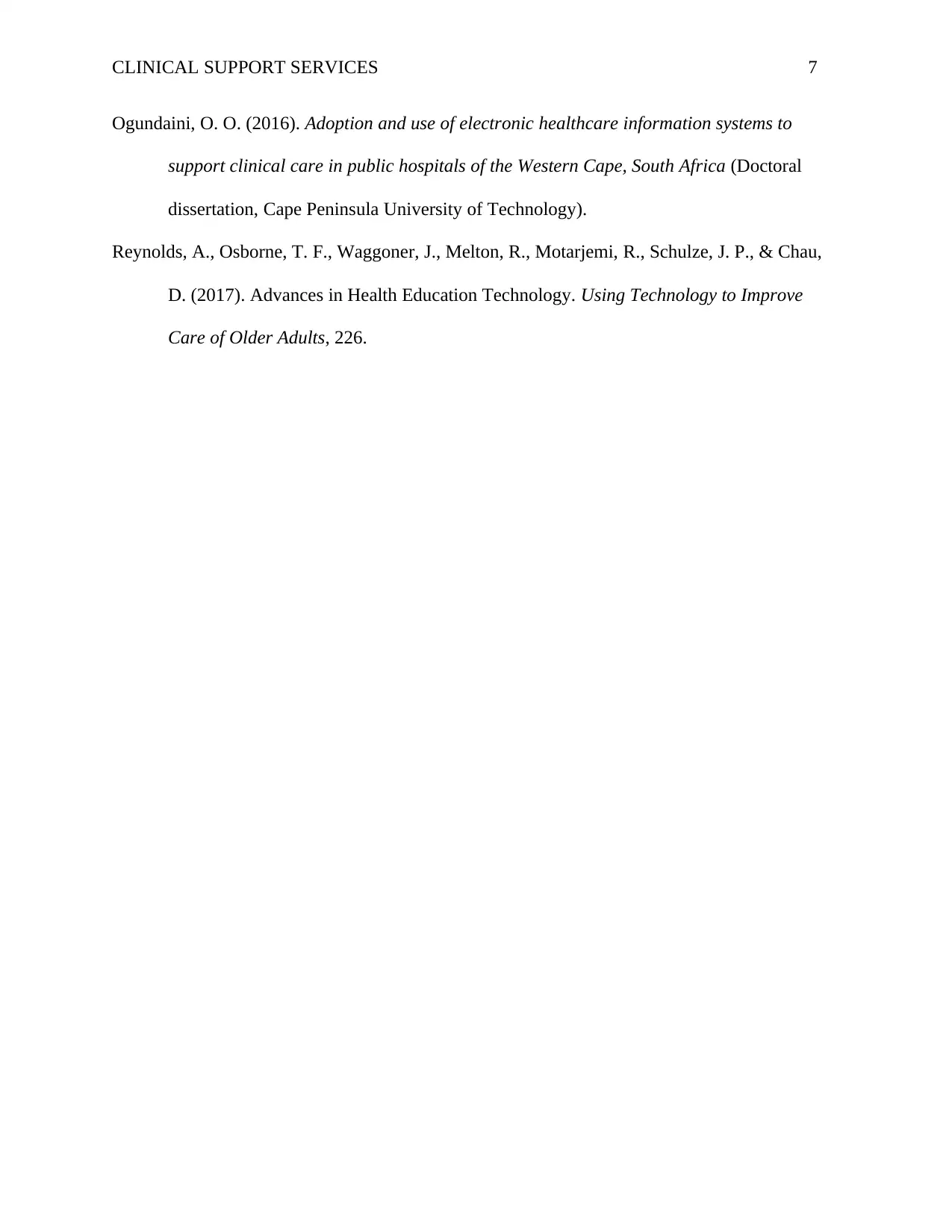Evaluating Investment Opportunities in Clinical Support Services
VerifiedAdded on 2023/03/21
|7
|1477
|46
Essay
AI Summary
This essay explores how Healthcare Organizations (HCOs) maintain up-to-date Clinical Support Services (CSSs) through investments in learning, training, and equipment. It identifies mechanisms for recognizing investment opportunities, such as market analysis, scalability, sustainability, and Return On Investment (ROI), and evaluates these opportunities using methods like ROI analysis, payback period technique, present worth method, and uniform annual cost method. The essay also examines the roles of HCO managers, CSS management, and governance in promoting continuous improvement and effective budgeting, highlighting the importance of negotiating financial goals, ensuring quality and satisfaction, and involving physicians and CSS personnel in the improvement process. Finally, it emphasizes the need for a programmatic capital review and board approval for funding proposals, citing relevant research and biblical principles to support its arguments. The paper references the textbook "The Well-Managed Healthcare Organization" and other credible sources to support its analysis.

CLINICAL SUPPORT SERVICES 1
Clinical Support Services
Student’s Name
Institution Affiliate
Date
Clinical Support Services
Student’s Name
Institution Affiliate
Date
Paraphrase This Document
Need a fresh take? Get an instant paraphrase of this document with our AI Paraphraser

CLINICAL SUPPORT SERVICES 2
The main goal in all healthcare organizations is providing patient satisfaction “at a level
that fully meets patients’ and caregiver’s needs”. Technology and protocols keep changing over
time. The healthcare team must keep up with education and certifications to continue learning to
be competent with these changes. An effective team also requires training to increase positive
health outcomes. Equipment needs to be reliable and function well for the safety of patients.
With the advancement in technology in the clinical support services, there is the need for the
retainment of capital by organizations to invest in new equipment, medicines, and training
programs.
To support these activities, the organization have specific funding and forecasting
department which keep in touch with the development companies of new products and machines.
Through continuous contact of the world leaders in medicine as well as the medical equipment
provider there will be an overall effectiveness of the particular forecasting regarding the
upcoming equipment and medicines (Ogundaini, 2016). Training programs are strategically
planned for any organizations which benefit the organization for slowing down the cost as well
as improving the effectiveness of the specific training program given in the particular
organization.
The Healthcare organization needs to invest lots of money on research and also
development. The management of the organization should also carry out market research and
have an awareness of happenings in the market to identify the gaps of their organization and
make adjustments where necessary (Macinko & Harris, 2015). This could be through the
initiation of training programs and recruitment of experts in the particular domain. There could
be both online and offline training on the current technologies to become updated.
The main goal in all healthcare organizations is providing patient satisfaction “at a level
that fully meets patients’ and caregiver’s needs”. Technology and protocols keep changing over
time. The healthcare team must keep up with education and certifications to continue learning to
be competent with these changes. An effective team also requires training to increase positive
health outcomes. Equipment needs to be reliable and function well for the safety of patients.
With the advancement in technology in the clinical support services, there is the need for the
retainment of capital by organizations to invest in new equipment, medicines, and training
programs.
To support these activities, the organization have specific funding and forecasting
department which keep in touch with the development companies of new products and machines.
Through continuous contact of the world leaders in medicine as well as the medical equipment
provider there will be an overall effectiveness of the particular forecasting regarding the
upcoming equipment and medicines (Ogundaini, 2016). Training programs are strategically
planned for any organizations which benefit the organization for slowing down the cost as well
as improving the effectiveness of the specific training program given in the particular
organization.
The Healthcare organization needs to invest lots of money on research and also
development. The management of the organization should also carry out market research and
have an awareness of happenings in the market to identify the gaps of their organization and
make adjustments where necessary (Macinko & Harris, 2015). This could be through the
initiation of training programs and recruitment of experts in the particular domain. There could
be both online and offline training on the current technologies to become updated.

CLINICAL SUPPORT SERVICES 3
The organization could identify investment opportunities through the following
mechanisms; market analysis, scalability, sustainability, good Return On Investment and
scalability. Market analysis involves assessment of the market to look into its size, the patterns,
competition, and the current economic environment. To stay relevant, the organization improve
its ability to handle any increase in market demands (Reynolds et al., 2017). This could be easily
achieved by building a solid foundation in the organization, embracing strategic planning as well
as focusing on the core strengths.
The sustainability strategy is necessary to be competitive and foster organization
longevity. This is the assumption on which sustainability is built. Return on Investment refers to
a performance measure that is used to evaluate the efficiency of an investment or get
comparisons of different investments (Kenneth et al., 2019). To keep up with technology, the
return on investment must be good. Salability, on the other hand, refers to making the
organization marketable by keeping in touch with the current technological trends.
Different organizations have their support system for keeping up the clinical support
system up to date. The mentioned strategies aid in creation of a better environment for an
organization in regards to the development of a strategy for purchasing new equipment and the
implementation of different training programs in a healthcare organization (Grant, 2017).
Electronic forecasting systems, as well as a variety of forecasting agencies, are among the most
important mechanisms used in this type of organization to successfully maintain the update of
the healthcare organization. Through successful evaluation of the need for newer technologies
and keeping in touch with the suppliers of the specific instruments, healthcare organizations
directly increase the overall level of implementation of the program.
The organization could identify investment opportunities through the following
mechanisms; market analysis, scalability, sustainability, good Return On Investment and
scalability. Market analysis involves assessment of the market to look into its size, the patterns,
competition, and the current economic environment. To stay relevant, the organization improve
its ability to handle any increase in market demands (Reynolds et al., 2017). This could be easily
achieved by building a solid foundation in the organization, embracing strategic planning as well
as focusing on the core strengths.
The sustainability strategy is necessary to be competitive and foster organization
longevity. This is the assumption on which sustainability is built. Return on Investment refers to
a performance measure that is used to evaluate the efficiency of an investment or get
comparisons of different investments (Kenneth et al., 2019). To keep up with technology, the
return on investment must be good. Salability, on the other hand, refers to making the
organization marketable by keeping in touch with the current technological trends.
Different organizations have their support system for keeping up the clinical support
system up to date. The mentioned strategies aid in creation of a better environment for an
organization in regards to the development of a strategy for purchasing new equipment and the
implementation of different training programs in a healthcare organization (Grant, 2017).
Electronic forecasting systems, as well as a variety of forecasting agencies, are among the most
important mechanisms used in this type of organization to successfully maintain the update of
the healthcare organization. Through successful evaluation of the need for newer technologies
and keeping in touch with the suppliers of the specific instruments, healthcare organizations
directly increase the overall level of implementation of the program.
⊘ This is a preview!⊘
Do you want full access?
Subscribe today to unlock all pages.

Trusted by 1+ million students worldwide

CLINICAL SUPPORT SERVICES 4
Evaluation of such strategies requires a proper understanding of the advancement in
technology as well as interpretation of the needs of the community. A variety of electronic
forecasting mechanism could also be used to analyze the opportunities of the ever-dynamic
technology (Ginter, Duncan, & Swayne, 2018). The Return On Investment approach is the best
method to evaluate investment opportunities. The healthcare organization needs to know what
they stand to gain from investing in a technology or service. This forms the basis for all the
evaluation mechanisms.
The payback period technique could also be used as a tool for evaluation of investment
opportunities. It uses the idea that revenues obtained from a particular investment should pay
back the investment in a certain period (Collen & Hammond, 2015). The present worth method
may also be used where the equivalent present value of the current and future cash flows are
used in the evaluation of the investment proposal. The Uniform annual cost method, another
mechanism of investment evaluation converts all current, and future cash flows to their
equivalent uniform annual costs using the given rates of return.
To keep all its CSSs up to date, the function implemented is the Promoting Continuous
Improvement Function. An example of the improvement initiatives is diagnostic imaging.
"Changes in technology will force many CSSs to make major revisions" (p. 263-264). Even
massive investments cannot compete with medical care changes.
The healthcare manager makes negotiations on both annual and long-term goals to optimize
patient needs as a whole. “The negotiating process has several important characteristics” (p.
265):
1) The actions that put HCO’s at risk must be avoided at all costs
Evaluation of such strategies requires a proper understanding of the advancement in
technology as well as interpretation of the needs of the community. A variety of electronic
forecasting mechanism could also be used to analyze the opportunities of the ever-dynamic
technology (Ginter, Duncan, & Swayne, 2018). The Return On Investment approach is the best
method to evaluate investment opportunities. The healthcare organization needs to know what
they stand to gain from investing in a technology or service. This forms the basis for all the
evaluation mechanisms.
The payback period technique could also be used as a tool for evaluation of investment
opportunities. It uses the idea that revenues obtained from a particular investment should pay
back the investment in a certain period (Collen & Hammond, 2015). The present worth method
may also be used where the equivalent present value of the current and future cash flows are
used in the evaluation of the investment proposal. The Uniform annual cost method, another
mechanism of investment evaluation converts all current, and future cash flows to their
equivalent uniform annual costs using the given rates of return.
To keep all its CSSs up to date, the function implemented is the Promoting Continuous
Improvement Function. An example of the improvement initiatives is diagnostic imaging.
"Changes in technology will force many CSSs to make major revisions" (p. 263-264). Even
massive investments cannot compete with medical care changes.
The healthcare manager makes negotiations on both annual and long-term goals to optimize
patient needs as a whole. “The negotiating process has several important characteristics” (p.
265):
1) The actions that put HCO’s at risk must be avoided at all costs
Paraphrase This Document
Need a fresh take? Get an instant paraphrase of this document with our AI Paraphraser

CLINICAL SUPPORT SERVICES 5
2) Competitive financial goals must be met for all parties. If the goals cannot be met, the
goals must be revised
3) Each CSS must look into its own needs to practice quality, patient satisfaction, caregiver
satisfaction, and associate satisfaction
4) The negotiating team should include physicians and CSS personnel who can see where
improvements need to take place
5) Include rewards to the CSS managers for an effective solution
In addition to the negotiating model, as Mikar mentioned, "CSS managers are responsible
for identifying opportunities and developing programmatic proposals to replace capital
equipment and or major revisions to service." In the end, all requests will be evaluated by
Programmatic Capital Review and a final list will be presented to the governing board. The
proposal is then funded based on the priority list (Falzon et al., 2016). The board may agree to
change its guidelines to put the desired recommendation into effect if needed.
2) Competitive financial goals must be met for all parties. If the goals cannot be met, the
goals must be revised
3) Each CSS must look into its own needs to practice quality, patient satisfaction, caregiver
satisfaction, and associate satisfaction
4) The negotiating team should include physicians and CSS personnel who can see where
improvements need to take place
5) Include rewards to the CSS managers for an effective solution
In addition to the negotiating model, as Mikar mentioned, "CSS managers are responsible
for identifying opportunities and developing programmatic proposals to replace capital
equipment and or major revisions to service." In the end, all requests will be evaluated by
Programmatic Capital Review and a final list will be presented to the governing board. The
proposal is then funded based on the priority list (Falzon et al., 2016). The board may agree to
change its guidelines to put the desired recommendation into effect if needed.

CLINICAL SUPPORT SERVICES 6
References.
Collen, M. F., & Hammond, W. E. (2015). Development of Medical Information Systems
(MISs). In The History of Medical Informatics in the United States (pp. 123-206).
Springer, London.
Falzon, D., Timimi, H., Kurosinski, P., Migliori, G. B., Van Gemert, W., Denkinger, C. &
Yassin, M. A. (2016). Digital health for the End TB Strategy: developing priority
products and making them work. European Respiratory Journal, 48(1), 29-45.
Ginter, P. M., Duncan, W. J., & Swayne, L. E. (2018). The strategic management of health care
organizations. John Wiley & Sons.
Grant, J. (2017). The good CPD guide: A practical guide to managed continuing professional
development in medicine. CRC Press.
Kenneth R. White, PhD, RN, FACHE, John R. Griffith, L FACHE (2019)The Well-Managed
Healthcare Organization, Eighth Edition,pg 250-480.
Macinko, J., & Harris, M. J. (2015). Brazil's family health strategy—delivering community-
based primary care in a universal health system. New England Journal of
Medicine, 372(23), 2177-2181.
References.
Collen, M. F., & Hammond, W. E. (2015). Development of Medical Information Systems
(MISs). In The History of Medical Informatics in the United States (pp. 123-206).
Springer, London.
Falzon, D., Timimi, H., Kurosinski, P., Migliori, G. B., Van Gemert, W., Denkinger, C. &
Yassin, M. A. (2016). Digital health for the End TB Strategy: developing priority
products and making them work. European Respiratory Journal, 48(1), 29-45.
Ginter, P. M., Duncan, W. J., & Swayne, L. E. (2018). The strategic management of health care
organizations. John Wiley & Sons.
Grant, J. (2017). The good CPD guide: A practical guide to managed continuing professional
development in medicine. CRC Press.
Kenneth R. White, PhD, RN, FACHE, John R. Griffith, L FACHE (2019)The Well-Managed
Healthcare Organization, Eighth Edition,pg 250-480.
Macinko, J., & Harris, M. J. (2015). Brazil's family health strategy—delivering community-
based primary care in a universal health system. New England Journal of
Medicine, 372(23), 2177-2181.
⊘ This is a preview!⊘
Do you want full access?
Subscribe today to unlock all pages.

Trusted by 1+ million students worldwide

CLINICAL SUPPORT SERVICES 7
Ogundaini, O. O. (2016). Adoption and use of electronic healthcare information systems to
support clinical care in public hospitals of the Western Cape, South Africa (Doctoral
dissertation, Cape Peninsula University of Technology).
Reynolds, A., Osborne, T. F., Waggoner, J., Melton, R., Motarjemi, R., Schulze, J. P., & Chau,
D. (2017). Advances in Health Education Technology. Using Technology to Improve
Care of Older Adults, 226.
Ogundaini, O. O. (2016). Adoption and use of electronic healthcare information systems to
support clinical care in public hospitals of the Western Cape, South Africa (Doctoral
dissertation, Cape Peninsula University of Technology).
Reynolds, A., Osborne, T. F., Waggoner, J., Melton, R., Motarjemi, R., Schulze, J. P., & Chau,
D. (2017). Advances in Health Education Technology. Using Technology to Improve
Care of Older Adults, 226.
1 out of 7
Related Documents
Your All-in-One AI-Powered Toolkit for Academic Success.
+13062052269
info@desklib.com
Available 24*7 on WhatsApp / Email
![[object Object]](/_next/static/media/star-bottom.7253800d.svg)
Unlock your academic potential
Copyright © 2020–2025 A2Z Services. All Rights Reserved. Developed and managed by ZUCOL.





